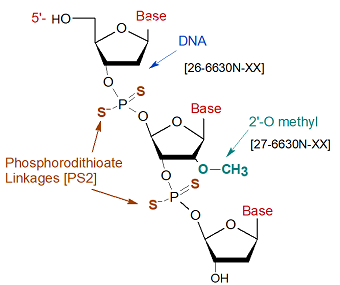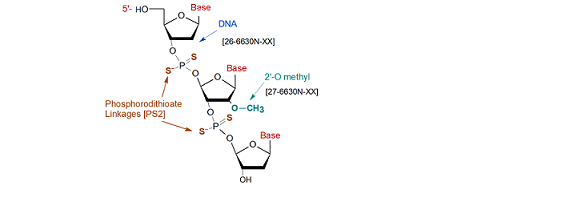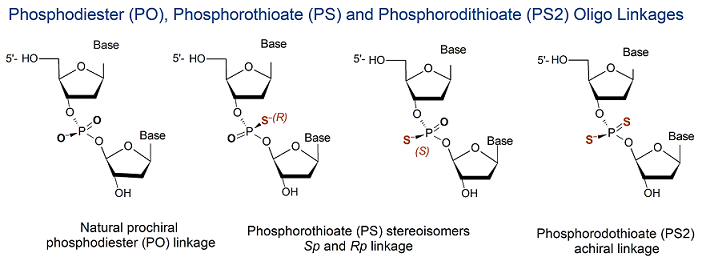
Modification : phosphorodithioate dC (PS2)
Catalog Reference Number
Category
Modification Code
5 Prime
3 Prime
Internal
Molecular Weight (mw)
Extinction Coeficient (ec)
Technical Info (pdf)
Absorbance MAX
Emission MAX
Absorbance EC
| Catalog No | Scale | Price |
| 26-6630C-05 | 50 nmol | $227.00 |
| 26-6630C-02 | 200 nmol | $227.00 |
| 26-6630C-01 | 1 umol | $310.00 |
| 26-6630C-03 | 2 umol | $376.00 |
| 26-6630C-06 | 5 umol | $564.00 |
| 26-6630C-10 | 10 umol | $910.00 |
| 26-6630C-15 | 15 umol | $1,310.00 |
| Discounts are available for phosphorodithioate dC (PS2)! |
| Modification* Discount Price Structure |
|
1 site/order
|
List price
|
|
2 sites/order
|
10% discount
|
|
3 sites/order
|
20% discount
|
|
4 sites/order
|
30% discount
|
|
5-9 sites/order
|
50% discount
|
|
10+ sites/order
|
60% discount
|
|
*Exceptions apply
|
Antisense Oligos (ODN) & siRNA Oligo Modifications
Click here for more information on antisense modifications, design & applications.
Phosphorothioate Linkage Minimum Pricing
Note that the above pricing are for phosphorodithioate bases only. There is additional charge for Phosphorothioate linkages with minimum charges for 15 sites per oligo.
Click here for Phosphorothioate pricing information based on scale of synthesis.
DNA & 2'O methyl Phosphorodithioate Linkages (PS2)
Gene Link offers phosphorodithioate (PS2) linkage modified DNA and 2'O methyl oligos. The phosphorodithioate linkage [PS2] are achiral and is a good substitute to obviate the disadvantage of phosphorothioate [PS] linkages that yield stereoisomers. Each phosphorothioate substitution can be either an "Sp" or "Rp" conformation. As such, a fully phosphorothioate 20 nt antisense oligonucleotide will be a mixture of more than half a million different molecules.

To avoid and/or reduce this type of complexity is to use achiral phosphorodithioates instead, where both non-bridged oxygen atoms are replaced with sulfurs. Phosphorodithioates share many of the desirable properties of phosphorothioates without the additional undesired stereocenters. (1,2) In addition, phosphorodithioates are even more stable to nucleases than their phosphorothioate counterparts.
Replacing two non-bridging oxygen atoms with sulfur atoms in a DNA phosphodiester linkage creates a phosphorodithioate (PS2) linkage (1). Like natural DNA, the phosphorodithioate linkage is achiral at phosphorus. This analog is completely resistant to nuclease degradation and forms complexes with DNA and RNA with somewhat reduced stabilities (2). Moreover, it has been found that PS2 oligos bind with a higher affinity than their phosphodiester analogue (2-6) suggesting that PS2 oligos may have additional utility in the form of sulfur-modified phosphate ester aptamers (thioaptamers) (3,6-8) for therapeutic and diagnostic applications.
The phosphorodithioate linkage (PS2) is both achiral and essentially resistant to nucleases. Previous studies have shown very interesting results which include observations that DNA with PS2 linkages activates RNase H in vitro, strongly inhibits human immunodeficiency virus (HIV) reverse transcriptase, induces B-cell proliferation and differentiation, and is completely resistant to hydrolysis by various nucleases. 2'OMe- RNA Thiophosphoramidites are RNA monomers designed to produce oligos combining the PS2 linkage with the 2'O-methyl ribose modification. These PS2-modified RNA oligos have potential for use in siRNAs and dithiophosphate aptamers (thioaptamers).
Phosphorodithioate References
1. W.S. Marshall, and M.H. Caruthers, Science, 1993, 259, 1564-70.
2. X. Yang, and E. Mierzejewski, New Journal of Chemistry, 2010, 34, 805-819.
3. W.T. Wiesler, and M.H. Caruthers, J Org Chem, 1996, 61, 4272-4281.
4. The Glen Report, 2008, 20.1, 4-6.
5. The Glen Report, 2015, 27.2, 4-5.
6. N.D. Abeydeera, et al., Nucleic Acids Res, 2016, 44, 8052-64.
7. P. Amero, et al., J Am Chem Soc, 2021, 143, 7655-7670.
8. K. Bleicher, et al. Oligonucleotides comprising a phosphorodithioate internucleoside linkage. WO2019122279A1, Jun 27, 2019
Phosphorothioate modification is to the backbone linkage modifying the phosphodiester linkage to phosphorothioate. Replacing one non-bridging oxygen atom with sulfur atom in a DNA phosphodiester linkage creates a phosphorothioate [PS] linkage. This imparts considerable nuclease resistance and is used widely in the design of antisense oligonucleotides (ODN).
An antisense oligonucleotide refers to a short, synthetic DNA or RNA strand that is complementary in sequence to a short target sequence on a particular mRNA strand, which upon specific hybridization to its target induces inhibition of gene expression. The mechanism of inhibition is based on two properties: first, the physical blocking of the translation process by the presence of the short double-stranded region, and second, in the case of antisense DNA, the resulting DNA-RNA duplex is susceptible to cleavage by cellular RNase H activity, which degrades the mRNA and prevents proper translation. The latter property is the classic mode of action for antisense oligos. The former property can be used when it is necessary to design an antisense oligo with certain modifications that result in it not supporting RNase-H activity (1,2).
Phosphorothioate Chiral Rp and Sp Isomers
Modification of the phosphodiester linkage to phosphorothioate by replacing a non-bridging oxygen atom creates additional stereocenters. Each phosphorothioate substitution can be either an 'Sp' or 'Rp' conformation. As such, a fully phosphorothioate 20 nt antisense oligonucleotide will be a mixture of more than half a million different molecules.
Rp and Sp are the two stereoisomers of phosphorothioate [PS] linkages.

Phosphorothioate References
1. Sazani, P., Kole, R. Therapeutic potential of antisense oligonucleotides as modulators of alternative splicing. (2003) J. Clin. Invest., 112: 481-486.
2. Juliano, R., Alam, Md.R., Dixit, V., Kang, H.(2008) Mechanisms and strategies for effective delivery of antisense and siRNA oligonucleotides. Nucleic Acids Res., 36: 4158-4171.
3. Chan, J.H., Lim, S., Wong, W.S. Antisense oligonucleotides: from design to therapeutic applications. (2006) Clin. Exp. Pharmacol. Physiol., 33: 533-540.
4. Kurreck, J. Antisense technologies. Improvement through novel chemical modifications. (2003) Eur. J. Biochem., 270: 1628-1644.
5. Crooke, S.T. (2004) Progress in antisense technology. Annu. Rev. Med., 55: 61-95.
Methyl phosphonate (mp) modification makes the phoshodiester linkage neutral charged. The solubility of the oligo in aqueous solutions slowly decreases with increasing mp linkages; consider incorporating as many standard phosphodiester linkages as well in the oligo. Increasing percentage of DMSO from 0.5 to 10% may be used to solubilize the oligo.
Methyl phosphonoamidites are deoxynucleoside amidites modified such that, when incorporated into an oligonucleotide, that base position will have a (electrically neutral) methyl phosphonate backbone linkage instead of the standard (negatively charged) phosphodiester linkage. Oligos containing one or more methyl phosphonate linkages will be resistant to nuclease degradation at those positions, and the lack of charge improves intracellular transport. Because of these properties, methyl phosphonolated oligos have been explored as anti-sense reagents (1). However, since methyl phosphonate linkages lower the oligo's cellular uptake (2) as well as the Tm of the duplex formed with its RNA target (3), and, most importantly, also interferes with activation of RNase H activity (4), considerable care must taken in choosing which, and how many, methyl phosphonate linkages to incorporate into a putative anti-sense oligo. In that regard, we note that 2'-O-Methyl RNA oligos containing a single 3'-end methyl phosphonate "cap" (to eliminate 3'-exonuclease degradation) have been successfully used as anti-sense reagents (5). In addition, DNA extension primers containing such a "cap" have been used to characterize the nuclease activity of the yeast telomerase complex (6). Methylphosphonolated anti-sense oligos have also been used successfully to "mask" sites in U1 and U2 snRNPs required for spliceosome formation, and thus interfere with mRNA splicing (7). Many of the unique properties of methylphosphonolated oligos are due to the introduction of chirality into the phosphodiester backbone by the methyl group (8).
Methyl phosphonate (mp) References
1. Sarin, P.S., Agrawal, S., Civeira, M.P., Goodchild, J., Ikeuchi, T., Zamecnik, P.C. Inhibition of acquired immunodeficiency syndrome virus by oligodeoxynucleoside methylphosphonates. (1988)
Proc. Natl. Acad. Sci. USA 85: 7448-7451.
2. Blake, K.R., Murakami, A., Spitz, S.A., Glave, S.A., Reddy, M.P., Ts'o, P.O., Miller, P.S. Hybridization arrest of globin synthesis in rabbit reticulocyte lysates and cells by oligodeoxyribonucleoside methylphosphonates. (1985)
Biochemistry,
24: 6139-6145.
3. Kibler-Herzog, L., Zon, G., Uznanski, B., Whittier, G, Wilson, W.D. Duplex stabilities of phosphorothioate, methylphosphonate, and RNA analogs of two DNA 14-mers. (1991)
Nucleic Acids Res. 19: 2979-2986.
4. Walder, J. Antisense DNA and RNA: progress and prospects. (1988)
Genes Dev. 2: 502-504.
5. Prater, C.E., Miller, P.S. 3'-Methylphosphonate-Modified Oligo-2'-O-methylribonucleotides and Their Tat Peptide Conjugates: Uptake and Stability in Mouse Fibroblasts in Culture. (2004)
Bioconjugate Chem. 15: 498-507.
6. Niu, H., Xia, J., Lue, N.F. Characterization of the Interaction between the Nuclease and Reverse Transcriptase Activity of the Yeast Telomerase Complex. (2000)
Mol. Cell. Biol. 20: 6806-6815.
7. Temsamani, J., Agrawal, S., Pederson, T. Biotinylated Antisense Methylphosphonate Oligodeoxynucleotides-Inhibition of Spliceosome Assembly and Affinity Selection for U1 and U2 Small Nuclear RNPs. (1991)
J. Biol. Chem. 266: 468-472.
8. Thiviyanathan, V., Vyazovkina, K.V., Gozansky, E.K., Bichenchova, E., Abramova, T.V., Luxon, B.A., Lebedev, A.V., Gorenstein, D.G. (2002) Structure of Hybrid Backbone Methylphosphonate DNA Heteroduplexes: Effect of R and S Stereochemistry.
Biochemistry. 416: 827-838.
Forty years of research have shown that antisense oligonucleotides have great potential to target mRNAs of disease-associated genes and noncoding RNAs. Among the vast number of oligonucleotide backbone modifications, phosphorothioate modification is the most widely used in research and the clinic. However, along with their merits are notable drawbacks of phosphorothioate oligonucleotides, including decreased binding affinity to RNA, reduced specificity, and increased toxicity. Here we report the synthesis and in vitro evaluation of the DNA analog mesyl phosphoramidate oligonucleotide. This oligonucleotide type recruits RNase H and shows significant advantages over phosphorothioate in RNA affinity, nuclease stability, and specificity in inhibiting key processes of carcinogenesis. Thus, mesyl phosphoramidate oligonucleotides may be an attractive alternative to phosphorothioates (1).
DNA analog in which the mesyl (methanesulfonyl) phosphoramidate group is substituted for the natural phosphodiester group at each internucleotidic position (2-5), the oligomers show significant advantages over the often-used DNA phosphorothioates in RNA binding affinity, nuclease stability, and specificity of their antisense action, which involves activation of cellular RNase H enzyme for hybridization-directed RNA cleavage. Biological activity of the oligonucleotide analog was demonstrated with respect to pro-oncogenic miR-21. A 22-nt anti-miR-21 mesyl phosphoramidate oligodeoxynucleotide specifically decreased the miR-21 level in melanoma B16 cells, induced apoptosis, reduced proliferation, and impeded migration of tumor cells, showing superiority over isosequential phosphorothioate oligodeoxynucleotide in the specificity of its biological effect. Lower overall toxicity compared with phosphorothioate and more efficient activation of RNase H are the key advantages of mesyl phosphoramidate oligonucleotides, which may represent a promising group of antisense therapeutic agents (1).
Mesyl Phosphoramidate (Ms, u) References
1. Miroshnichenko, S.K., Patutina, O.A., Burakova, E.A., Chelobanov, B.P., Fokina, A.A., Vlassov, V.V., Altmanb, A., Zenkova, M.A., Stetsenko, D. A. Mesyl phosphoramidate antisense oligonucleotides as an alternative to phosphorothioates with improved biochemical and biological properties.
PNAS 2019.
116 : 1229-1234.
2. Prokhorova, D. V., Chelobanov, B.P., Burakova, E.A., Fokina, A.A., Stetsenko, D.A. (2017) New oligodeoxyribonucleotide derivatives bearing internucleotide N-tosyl phosphoramidate groups: Synthesis and complementary binding to DNA and RNA. Russ. J. Bioorganic Chem. 43:38-42.
3. Chelobanov,B.P., Burakova,E.A., Prokhorova,D.V., Fokina, A.A., Stetsenko,D.A. (2017) New oligodeoxynucleotide derivatives containing N-(methanesulfonyl)-phosphoramidate (mesyl phosphoramidate) internucleotide group. Russ. J. Bioorganic Chem. 43:664-668.
4. Boyer, J. H.; Mack, C. H.; Goebel, W.; Morgan, L. R. (1959) Reactions of Sodium Phenylacetylide and Sodium Alkoxide with Tosyl and Mesyl Azides. Jr. J. Org. Chem., 23: 1051-1053.
5. Taber, D.F., Ruckle, R.E. Jr., Hennessy, M.J., (1986) Mesyl Azide: A Superior Reagent for Diazo Transfer. J. Org. Chem., 51:4077-4078
Oligo Modifications for ASO's and siRNA Delivery.
The development of effective delivery systems for antisense oligonucleotides is essential for their clinical therapeutic application. The most common delivery system involves a relatively hydrophobic molecule that can cross the lipid membrane. Cholesterol TEG, alpha-Tocopherol TEG ( a natural isomer of vitamin E), stearyl and GalNAc modifications have been shown to effective for delivery of ASO's and siRNA in addition to cell penetrating peptides.
Click this link to view these modifications.
- phosphorodithioate dC (PS2)
